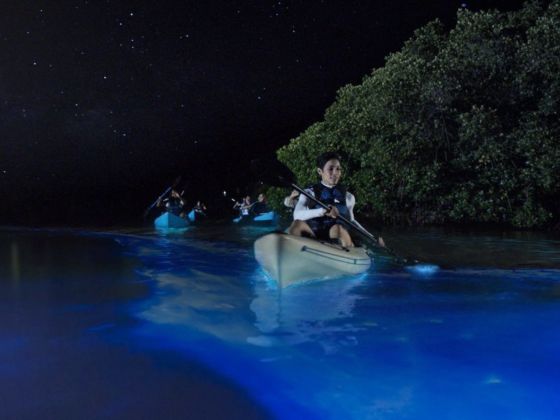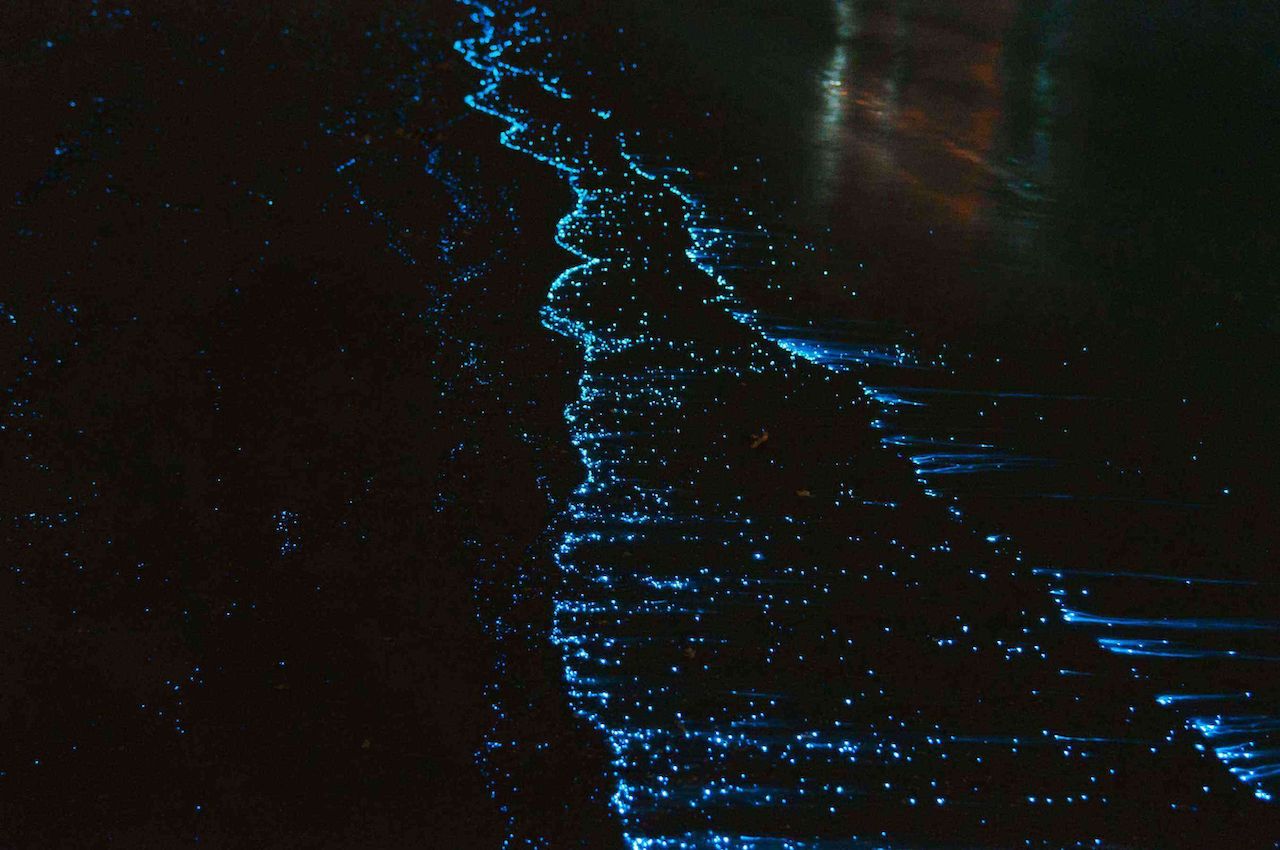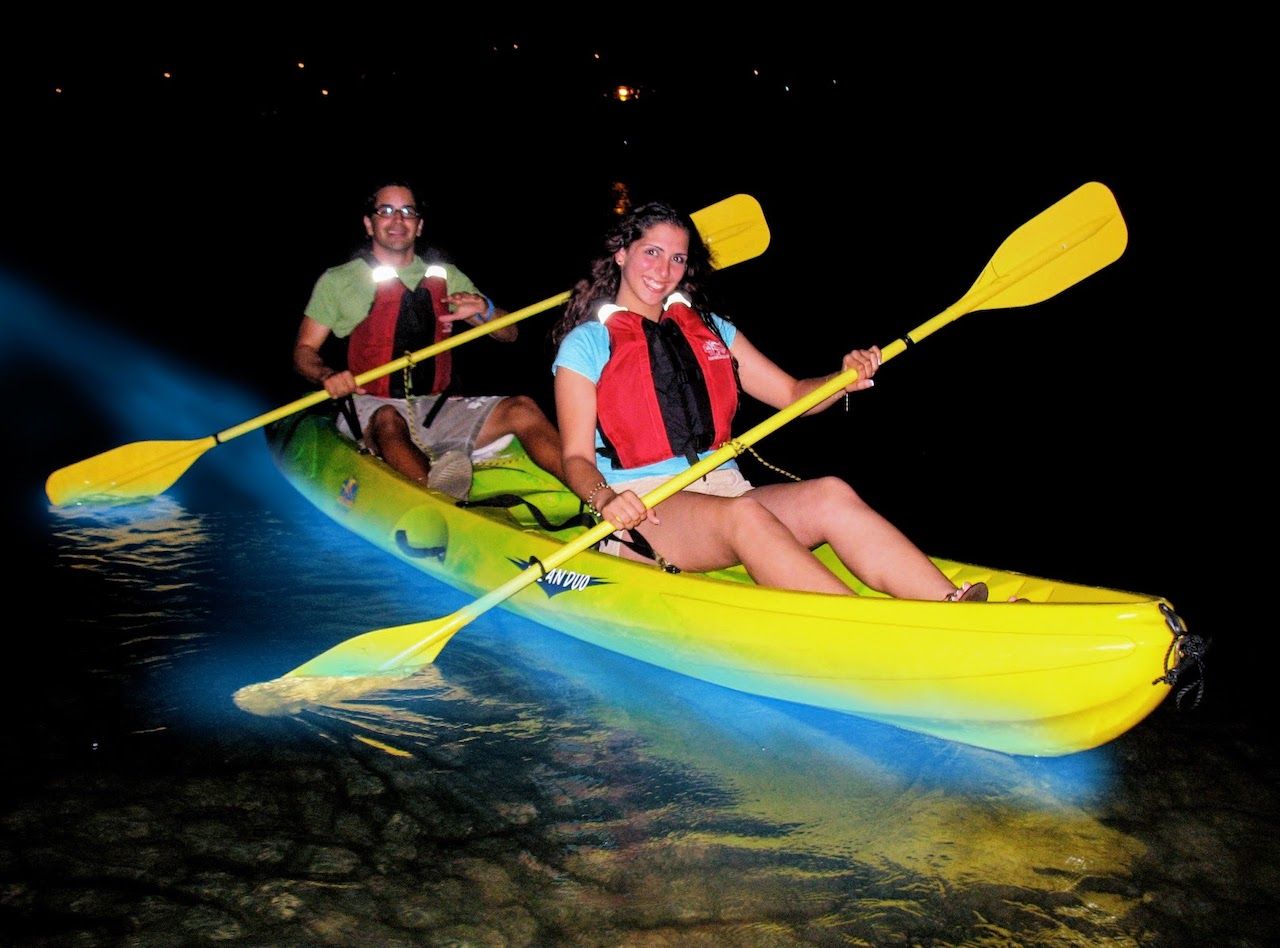The docks of Lajas, Puerto Rico feel more like a tourist trap than a gateway to a natural world wonder. Reggaeton music blasts, vendors sell keychains and light-up jewelry, and posters tout the dazzling magic of the neon blue bioluminescent bay — yours to discover through dozens of tour guides and boat rentals. For a glow allegedly so bright, it’s nowhere to be seen on the shoreline.


How to Experience the Magic of Puerto Rico’s Surreal Bioluminescent Bays
I hop into a sizeable motorboat manned by a small crew with my island tour guides, and my skepticism is dulled by an ice-cold Medalla Light. The engine purrs and we pull away from the docks, the music and crowds quickly fading away and the stars beginning to show themselves. Some 20 minutes later, I audibly gasp. Our boat is leaving a trail on the surface of the water that can only be described as fairy dust.
It’s not radiating nuclear blue like the advertisements, but the effect is actually more astounding. The water twinkles a bright, greenish-blue and disappears so quickly that you’d think you imagined it. Silhouettes of fish appear briefly as they swim by the boat, and leave arcs of light if they hop out of the water. When the boat comes to a stop in the middle of the bay, it’s dead silent — the water is large enough that other boats need not disturb their neighbors. The captain beckons me to the stern of the boat.
“Jump in.”
I laugh, considering I’m wearing skinny jeans, a sequined top, and a few layers of mascara. “Wish I could. I was told I didn’t need to wear a bathing suit.”
“So? This is a once-in-a-lifetime experience. You came all this way. When will you be here again? Just jump in.”
To someone with a deep-seated case of FOMO, that’s all you need to say. That, and an offer to borrow the burly deckhand’s spare swimming trunks.
So I take the plunge, hands clasped tightly on my waistband, into water that feels like a warm bathtub and looks like Pandora. Sparkling specks follow my every movement, twirling around my legs as I’m flapping them like a mermaid’s tail. If I reach above the surface, blue dots catch in the hairs on my arm like glowing beads of sweat. My Puerto Rican companions laugh at my childlike glee, and the captain continues to explain the science in great detail. But I’m hardly listening. I’m too busy moving my hands under the water in rapid circles, creating fleeting orbs of glistening light and pretending I’m a wizard.
What are bioluminescent bays?

Photo: Isabella Miller/Shutterstock
Though it’d be quite easy to convince someone that the glowing effect was from some magic sea creature of the deep, the glittering specks are dinoflagellates, single-celled microorganisms that illuminate when agitated. Any movement, be it the tail of a fish, the stroke of a paddle, or — most spectacularly — a swimming body, will make the water appear as if it’s glowing. While these microorganisms are found throughout the ocean, they need to be in extremely high concentration in order to appear visible to the naked eye. As in, thousands upon thousands in a single gallon. There are only five proper bioluminescent bays in the world where the concentration of dinoflagellates is high enough, and a whopping three of them are found in Puerto Rico (the other two are in Jamaica and Vietnam), each offering different worthwhile experiences.
Whether you can extend your San Juan trip with a nearby night excursion or are able to journey all the way across the island, visiting a bioluminescent bay is something you shouldn’t leave Puerto Rico without doing. Here’s everything you need to know about the bio bays in advance to make the most of your experience.
The three bio bays of Puerto Rico
1. La Parguera, Lajas
Located in the southwest corner of Puerto Rico near Cabo Rojo, La Parguera is the only bay that allows motorboats. While that could seem like a drawback as it means more noise disturbance, the motorboats allow you to get really far from the docks very quickly and deep into the bay. A world away from the thudding dance parties of Lajas, the boats shut off their engines and immerse you in complete silence. La Parguera is also the only bay that allows swimming, which is something you simply cannot pass up no matter your fears about diving into pitch-black water and thousands of microorganisms. If you’re willing to splurge for a glass-bottomed boat, all the more magical.
2. Laguna Grande, Fajardo
If your trip to Puerto Rico is based around San Juan, you can still squeeze in a visit to bioluminescent waters at Laguna Grande, located about an hour outside of the capital city. While not technically a bay, but a lagoon, Laguna Grande is best experienced by kayak. A round-trip journey down a narrow canal to the lagoon takes about two hours. While swimming isn’t permitted, no one will scold you for running your fingers through the water and creating swirling patterns. If you’re not comfortable kayaking, you can also peek at the waters from afar by walking along a boardwalk through a mangrove swamp.
3. Mosquito Bay, Vieques
Reaching the island of Vieques seven miles off the east coast of Puerto Rico will take advance planning. Being that you need to visit the bio bay at night for maximum darkness and ferries don’t run that late, you’ll need to stay overnight on the island. It’s absolutely worth it, though, as Mosquito Bay has the honor of being the brightest bioluminescent bay in the world, according to a 2006 Guinness World Record. It has not only held onto that title, but doubled down on it, after Hurricane Maria unexpectedly doubled the concentration of dinoflagellates in the water. Mosquito Bay also has the least light pollution, thanks to its remote location, so you’ll enjoy spectacular stargazing in addition to glowing water. Like Laguna Grande, Mosquito Bay doesn’t allow motorboats or swimming, so kayaking is your best option. And don’t worry about the unpleasant name — Mosquito Bay has no more flying pests than any other body of water in Puerto Rico.
Everything you need to know before visiting a bio bay

Photo: Discover Puerto Rico
1. Visit during the new moon for minimal light pollution.
Absolute darkness is a must for seeing the bio bays in all their glowing glory. For optimal viewing, plan your visit around a new moon. The bioluminescence will still be visible during a full moon, but it will be significantly dimmer. A cloudy evening is ideal for nights when the moon is out, but don’t despair if it’s a clear night — the stargazing will be phenomenal.
2. Book tours in advance.
Most of the time you shouldn’t have a problem walking up to a rental kiosk and getting a kayak or boat, but rather than risking disappointment or waiting for hours, book a tour in advance. This is especially crucial at La Parguera, where you can take a glass-bottomed motorboat onto the water. Booking a tour also means you’ll have a guide who can explain the science behind the bioluminescence, take you straight to the spots with the highest concentrations of dinoflagellates, and make sure you get back ashore safely and within a reasonable amount of time. You can also call in advance to request an English-speaking guide.
3. Minimize your environmental impact.
The ecosystem of the bio bays is very fragile, and the more you can do to mitigate the impact of tourism, the better. Avoid wearing sunscreen (it is night, after all) or lotions that contain chemicals that may harm the bays, especially at La Parguera where you can swim. If you’re especially concerned about not disturbing the ecosystem, opt for a kayak instead of a motorboat if given the choice, and respect any rules against swimming. And, of course, be a good human and don’t litter, spill any food or drink into the waters, or try to take a sample of the water back with you.
4. Bring a camera capable of ultra-long exposure.
Let’s make one thing perfectly clear: You will NOT get a photo of the bioluminescence on your phone. Or most digital cameras. If you’re dead set on getting a jaw-dropping shot for Instagram, you’d better have a professional camera capable of long-exposure photography, similar to what you would need for capturing the Milky Way. You’ll need to stabilize the camera as best as possible (ideally with a tripod, which could prove difficult on a kayak), use manual focus, a high ISO setting, and a wide aperture. If this means nothing to you, that’s fine. Relax, put the camera away, and just enjoy the moment.
5. Manage your expectations.
Despite what the photos advertising the bays would have you believe, the entire bay is not filled with radioactive neon blue water at all times. The water only glows when the microorganisms are disturbed by movement. The effect may be fleeting and fainter than you’d imagined, but it’s still a surreal experience. Go in with this understanding, and you will not be disappointed by the no-less-magical reality.